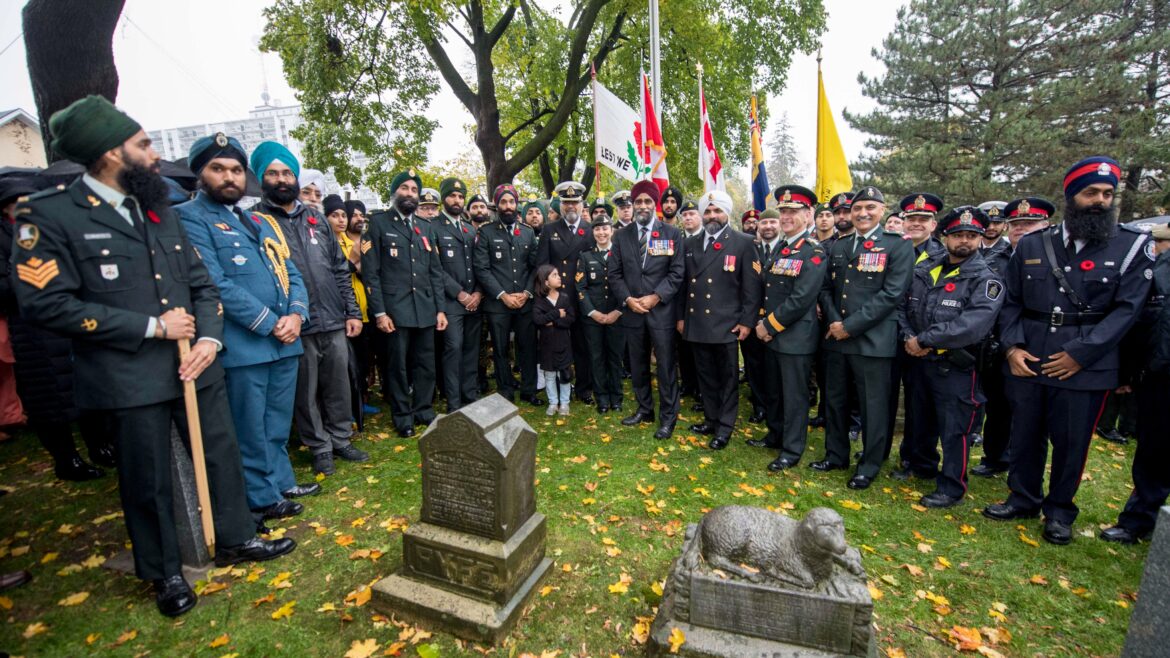For more than a century, Sikhs have proudly served in the Canadian armed forces—contributing to the nation’s defense and global missions, from World War I to modern peacekeeping efforts. As Canada prepares to observe Remembrance Day, Montreal-based businessman and historian Baljit Singh Chadha has revisited the heroic contributions of Sikh soldiers who fought for Canada in the First World War.
To commemorate their legacy, Canada Post will issue a special themed stamp honoring Sikh Canadian soldiers. The stamp will be formally unveiled to the public on November 2 at the 18th Annual Sikh Remembrance Day Ceremony, hosted by the Sikh community.
“The special stamp is to commemorate and honor Sikh soldiers who have remained part of the Canadian military for over 100 years, including 10 Sikh soldiers who were enlisted for World War I,” Canada Post announced.
Chadha, author of “History of the Sikhs in Quebec,” noted that of the 10 known Sikhs who served Canada during World War I, at least two – Sunta Gouger Singh and Waryam Singh—had strong ties to Quebec. “Most of the others would also have likely undergone training at Camp Valcartier in Quebec,” he added.
“Sunta Gouger Singh, born in Lahore, Punjab, in 1881, enlisted at the Peel Street Barracks in Montreal on January 6, 1915, at the age of 32. His father and wife lived in Phillaur, Punjab, India. He had served for three years in the 32nd Punjab Rifles of the Indian Army. He joined the 24th Battalion (the Quebec Regiment) and sailed from Montreal to England on the S.S. Cameronia in May 1915. The battalion arrived in Boulogne, France, in September 1915,” Chadha wrote.
Gouger Singh was killed in action on October 19, 1915, near Kemmel, Belgium, during intense artillery bombardments. His final resting place is the La Laterite Military Cemetery, among 197 Canadian soldiers from three infantry battalions.
“Strangely, Gouger Singh’s gravestone does not have the expected Canadian Maple Leaf, though his Canadian Battalion number is noted,” Chadha observed. “The inscription is very unusual for a Canadian gravestone. The script is in the Gurmukhi language and reads: ‘God is one’ and ‘Victory is to God.’ There is no cross on the stone.”
The second Sikh soldier with Quebec ties, Waryam Singh, enlisted in Barriesfield, Ontario, in May 1915 and served in the 59th and 38th Battalions (Eastern Ontario Regiment). His service record spanned multiple locations: five months in Canada, ten months in Bermuda, and two months in England before he arrived in France in August 1916.
The Quebec Chronicle of December 31, 1917, recorded that the first passengers to cross the newly opened Quebec Bridge were returning soldiers—among them, Waryam Singh. “The Gazette reported that they ‘were brought directly through to the local discharge depot by special train which passed over the recently completed structure,’” Chadha wrote, citing The Gazette (January 1, 1918).
He further quoted The Vancouver Daily World (January 7, 1918): “The men enjoyed a most lavish welcome from the citizens all along the route from the east. At Quebec, Kenora, Calgary, Field and other places the patriotic and appreciative people turned out in crowds and showered the wounded and crippled men with gifts of all kinds.”
Waryam Singh was discharged in Vancouver in March 1918, though he continued to suffer from a shoulder injury.
During his deployment in France, Waryam Singh wrote several letters to his father, Wazir Singh, in Kapurthala, India. In one dated November 1916, during the Battle of the Somme, he wrote:
“On the 4th of November there was a big fight, and much hand-to-hand fighting took place and many prisoners were taken… When we took the trenches some of the enemy escaped and some were taken. The dead were countless. The bravery which we showed that day was the admiration of the British soldiers. After the fight they asked me how it was that I was so utterly regardless of danger.”
Later, at Vimy Ridge in April 1917, Singh was wounded in the shoulder but refused to leave his post. He subsequently contracted trench fever and pneumonia, spending nearly eight months recovering in hospitals in France and England. After surgery to remove shrapnel, he was invalided home to Canada aboard the hospital ship Braemar Castle in December 1917.
As the Sikh community gathers this November to mark Sikh Remembrance Day, the Canada Post stamp stands as both a symbol of recognition and a testament to the bravery and sacrifice of Sikh soldiers who fought under the Canadian flag.
Baljit Singh Chadha emphasized that these stories remind Canadians that the nation’s defense history is deeply multicultural and enriched by contributions from communities across the world. “Their courage, faith, and sacrifice form an integral part of Canada’s story,” he said.






